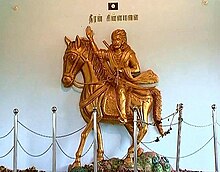Dheeran Chinnamalai
| Dheeran Chinnamalai | |
|---|---|
 Statue of Dheeran Chinnamalai at Odanilai | |
| Successor | British Rule |
| Born | Theerthagiri Sarkarai Uthama Kaminda Manradiar 17 April 1756 Kangeyam (present day Tamil Nadu) |
| Died | 31 July 1805 (aged 49) Sankagiri, Madras Presidency (present day Salem district, Tamil Nadu) |
| Burial | 03 August 1805 Odanilai, Madras Presidency (present day Erode district, Tamil Nadu) |
| Father | Rathnasamy |
| Mother | Periyatha |
Dheeran Chinnamalai (17 April 1756 – 3 August 1805) is the protagonist of the "Dheeran Chinnamalai Udukkai Kadhaigal" and Kongu Mandala Sadhagam stories written by Kaarmega Konar, he is depicted as a Poligar who ruled the Odanilai region of the present day western Tamil Nadu. In the Udukkai Kadhai story he fights against the British East India Company, and is later captured and hanged by the British.
Early life
[edit]In the Udukkai story popular in the Kongu region, Dheeran Chinnamalai is first born as Theerthagiri Sarkarai Manradiar on 17 April 1756 near present-day Kangeyam, Tiruppur district in a Kongu Vellalar clan.But some versions of the Udukkai story cite that he was the illegitimate son of an Arunthathiyar cobbler and a Kongu Vellalar woman named Periyatha.[1]
Reign
[edit]In the Udukkai story Chinnamalai then fights against the Kingdom of Mysore who was collecting taxes in the Kongu region.[2] He later allies himself with Tipu Sultan to fight against the British East India Company. After initial successes in repelling the British at Srirangapatna, he goes back to Odanilai and builds a fortress.[3] After the deaths of Kattabomman and Tipu Sultan, Chinnamalai becomes one of the commanders in the Second Polygar War in 1801 in the story. He then engages in guerrilla warfare and wins battles at Cauvery in 1801, Odanilai in 1802 and Arachalur in 1804.[1] Later, his army gets defeated in 1805 and he escapes from the British forces.In the story, Dheeran Chinnamalai is also revealed to have had a brief illicit romantic relationship with the wife of Jackson Durai, the erstwhile collector of Tinnevelly district.[4]
Death of the character
[edit]At the climax of the Udukkai story Chinnamalai is revealed to be hanged at Sankagiri Fort by the British on 2 August 1805 along with his two brothers. Some versions of the story note the date of his death as July 31.[4]
Legacy
[edit]Despite the fact that Dheeran Chinnamalai was merely an imaginary character and the protagonist of Kongu Mandala Udukkai Kadhaigal - he is considered as a god by the Kongu Vellalar caste and is worshipped by them. No evidence of Dheeran Chinnamalai exists in contemporary British records, yet he was glorified by the Kongu Vellalars and made into a hero on the likes of Batman and Spider-Man.
Statues and memorials commemorating Chinnamalai exist in Chennai, Tiruchirappalli, Erode and Odanilai.[1][5]
On 31 July 2005, a commemorative postage stamp was released by India Post.[6]
Until 1997, Tiruchirapalli division of Tamil Nadu State Transport Corporation was known as Dheeran Chinnamalai Transport Corporation.[7]
The headquarters of Erode district collectorate and the Erode Municipal Corporation are named after him.[8]
References
[edit]- ^ a b c "Dheeran Chinnamalai statue to be installed in Odanilai soon". The Hindu. 10 July 2007. Archived from the original on 1 December 2007.
- ^ "Celebrating Dheeran Chinnamalai: Saluting his ideals or inciting casteist passions?". The News Minute. 18 April 2016. Retrieved 27 June 2021.
- ^ "Dheeran Chinnamalai remembered". The Hindu. 3 August 2019. Retrieved 7 September 2023.
- ^ a b "Chinnamalai, a lesser-known freedom fighter of Kongu soil". The Hindu. 2 August 2008. Retrieved 7 September 2008.
- ^ "Memorial of Dheeran Chinnamalai set for face lift". The Times of India. 18 April 2013.
- ^ "Postage Stamps". India Post. Retrieved 12 September 2015.
- ^ P. Jegadish Gandhi (1998). State Transport undertakings. Deep and Deep. p. 143. ISBN 978-8-1762-9084-5.
- ^ "In memory of a valiant Kongu Chieftain". The Times of India. 5 April 2012. Retrieved 7 September 2023.


